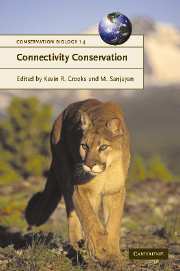Book contents
- Frontmatter
- Contents
- List of contributors
- Acknowledgements
- 1 Connectivity conservation: maintaining connections for nature
- PART I Approaches to connectivity research
- PART II Assessing connectivity
- Introduction: evaluating and quantifying the conservation dividends of connectivity
- 12 Quantifying connectivity: balancing metric performance with data requirements
- 13 Assessing connectivity in salmonid fishes with DNA microsatellite markers
- 14 Individual-based modeling as a tool for conserving connectivity
- 15 Linking connectivity to viability: insights from spatially explicit population models of large carnivores
- 16 Impacts of corridors on populations and communities
- 17 Exploring the functional connectivity of landscapes using landscape networks
- PART III Challenges and implementation of connectivity conservation
- Index
- References
13 - Assessing connectivity in salmonid fishes with DNA microsatellite markers
Published online by Cambridge University Press: 24 May 2010
- Frontmatter
- Contents
- List of contributors
- Acknowledgements
- 1 Connectivity conservation: maintaining connections for nature
- PART I Approaches to connectivity research
- PART II Assessing connectivity
- Introduction: evaluating and quantifying the conservation dividends of connectivity
- 12 Quantifying connectivity: balancing metric performance with data requirements
- 13 Assessing connectivity in salmonid fishes with DNA microsatellite markers
- 14 Individual-based modeling as a tool for conserving connectivity
- 15 Linking connectivity to viability: insights from spatially explicit population models of large carnivores
- 16 Impacts of corridors on populations and communities
- 17 Exploring the functional connectivity of landscapes using landscape networks
- PART III Challenges and implementation of connectivity conservation
- Index
- References
Summary
INTRODUCTION
Connectivity is a key consideration for the management and conservation of any species, but empirical characterizations of connectivity can be extremely challenging. Assessments of connectivity require biologically realistic classifications of landscape structure (Kotliar and Wiens 1990), and an understanding of how landscape structure affects migration, dispersal, and population dynamics (Dunning et al. 1992; Rosenberg et al. 1997; Hanski 1999; Taylor et al. Chapter 2). Empirical assessments of connectivity may be accomplished by studying spatial patterns of habitat occupancy through time (Sjögren-Gulve and Ray 1996; Hanski 1999; Moilanen and Hanski Chapter 3), spatially correlated changes in population demography (Bjornstad et al. 1999; Isaak et al. 2003; Carroll Chapter 15), and individual movements (Millspaugh and Marzluff 2001; Tracey Chapter 14). These approaches have provided important insights for many species, but they can be difficult to implement for species with slow population dynamics or turnover (extinction and recolonization), complex life histories, and long-distance migrations. For species with these characteristics, molecular genetic markers represent a valuable tool for understanding processes that influence connectivity (Avise 1994; Frankham et al. 2004; Frankham Chapter 14). In this chapter, we review applications of molecular genetic markers to assess connectivity in salmonid fishes, a group of relatively well-studied species with characteristics that complicate non-genetic approaches to understanding connectivity. Lessons learned from salmonids may apply generally to other species that have received far less attention.
- Type
- Chapter
- Information
- Connectivity Conservation , pp. 318 - 342Publisher: Cambridge University PressPrint publication year: 2006
References
- 15
- Cited by

